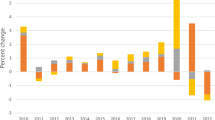Abstract
Economic developments of the past three decades posed new questions to economists: what are the causes of fluctuations in rates of return to human capital? What is the relation between the changing skill–wage structure and changing overall wage inequality? Does the widening of the wage structure produce an equilibrating supply response? What are the causes, dimensions, and implications of the “technological cycle” for wages, unemployment, and its “natural rate”? Why is the long-term trend of human capital formation relentlessly upward?
My research of the past decade, among that of other economists, attempted to provide answers to these questions, as described above. In the course of the analysis several misconceptions are clarified: (1) The view of an increasing “wage gap” as a worsening “social divide” misses the incentive effects of the increased rates of return on furthering investments in human capital. These are empirically documented. (2) Growing overall wage inequality can conceal a declining inequality of opportunity as it did in recent decades. (3) Technological unemployment as an aggregate phenomenon appears to be a myth. (4) The concurrent supply response to increasing demand for human capital applies to investments, not to the stock. The cumulation of investments (such as enrollments) over time produces a lag in the response of the human capital stock. This lag is a basic cause of the “technological cycle.”
Finally, it is worth noting that a positive skill bias is not inherent in technological changes. These may sometimes carry a negative effect on the demand for human capital. The implications of “deskilling” (the assembly line is an example) would be the opposite of what we found for the recent decades (1970–2000). However the long-term growth of human capital suggests a positive skill-bias in the long run.
Similar content being viewed by others
References
Bartel, Ann and Nachum Sicherman. (1998). “Technological Change and Skill Acquisition of Young Workers.” Journal of Labor Economics 16(4), 718-755.
Becker, Gary S. (1967). Woytinsky lecture. University of Michigan 1967. Also in Chapter 4, Section 3 of Human Capital (2nd edn). (1975). University of Chicago.
Bound, John and George Johnson. (1992). “Changes in the Structure of Wages in the 1980's.” American Economic Review 82, 371-392.
Chiswick, Barry R. and Jacob Mincer. (1972). “Time Series Changes in Personal Income Inequality.” Journal of Political Economy 80, S34-S66.
Cyert, Richard and David C. Mowery. (1988). The Impact of Technological Change on Employment and Economic Growth. Cambridge, MA: Ballinger Publishing Company.
Danninger, Stephan and Jacob Mincer. (2000). “Technology, Unemployment, and Inflation.” Research in Labor Economics 19, 1-28.
Freeman, Richard B. (1976). The Overeducated American. New York: Academic Press.
Freeman, Richard B. (1979). “The Effect of Demographic Factors on the Age-earnings Profile in the U.S.” Journal of Human Resources 14, 289-318.
Freeman, Richard B. (1986). “Demand for Education.” In Orley Ashenfelter and Richard Layard (eds.), Handbook of Labor Economics (Chap. 6). Amsterdam: North Holland.
Goldin, Claudia and Lawrence F. Katz. (1999). “The Return to Skill in the U.S.” NBER WP 7126.
Goodman, Leo. (1960). “On the Exact Variance of a Product.” Journal of the American Statistical Association, December.
Griliches, Zvi. (1969). “Capital-Skill Complementarity.” Review of Economics and Statistics 51, 465-478.
Johnson, William R. and Jonathan Skinner. (1986). “Labor Supply and Marital Separation.” American Economic Review 76, 455-469.
Jorgenson, Dale, Frank M. Gollop, and Barbara Fraumeni. (1990). Productivity and the U.S. Economic Growth. Cambridge, MA: Harvard University Press. Updated series, 1990.
Juhn, Chinhui, Kevin M. Murphy, and Brooks Pierce. (1993). “Wage inequality and the rise in the returns to skill.” Journal of Political Economy 101, 410-442.
Katz, Lawrence F. and Kevin M. Murphy. (1992). “Changes in Relative Wages 1963–1987.” Quarterly Journal of Economics 107, 35-78.
Krueger, Alan. (1993). “How Computers have Changed the Wage Structure.” Quarterly Journal of Economics 108, 33-60.
Levy, Frank and Richard J. Murnane. (1992). “U.S. Earnings Levels and Earnings Inequality.” Journal of Economic Literature 30, 1333-1381.
Mattila, J. Peter. (1982). “Determinants of Male School Enrollments.” The Review of Economics and Statistics 64, 242-251.
Mincer, Jacob. (1974). Schooling, Experience, and Earnings. New York: Columbia University Press.
Mincer, Jacob. (1991). “Human Capital, Technology, and the Wage Structure: What Do Time Series Show?” NBER WP 3581, published as Chapter 13 in Jacob Mincer, Studies in Human Capital, E. Elgar, 1993.
Mincer, Jacob. (1996a). “Changes in Wage Inequality, 1970–1990.” NBER WP 5823, November. (Published in S. Polachek [ed.], Research in Labor Economics [Vol. 16, pp. 1-18]. Greenwich, CT: JAI Press, 1997).
Mincer, Jacob. (1996b). “Economic Development, Human Capital, and Wage Dynamics.” Journal of Economic Growth 1, 29-49.
Mincer Jacob. (1998). “Investments in U.S. Education and Training as Supply Responses.” Research in Labor Economics 17, 277-304.
Nelson, Richard and Edmund Phelps. (1966). “Investments in Humans, Technological Diffusion, and Economic Growth.” American Economic Review 56, 69-75.
Schultz, Theodore W. (ed.). (1975). “The Ability to Deal with Disequilibria.” Journal of Economic Literature 13, 827-846.
Schumpeter, Joseph. (1934). The Theory of Economic Development. Cambridge: Harvard University Press.
Schumpeter, Joseph. (1939). Business Cycles. New York, London, McGraw-Hill Book Company, Inc.
Tinbergen, Jan. (1975). Income Distribution: Analysis and Policies. Amsterdam: North-Holland Pub. Co.; New York: American Elsevier.
U.S. Department of Labor (1985). “How Workers Get their Training.” BLS Bulletin.
U.S. Department of Labor (1992). “How Workers Get their Training: An Update.” BLS Bulletin 2407, August.
Welch, Finis. (1970). “Education in Production.” Journal of Political Economy 78, 278-282.
Welch, Finis. (1979). “Effects of Cohort Size on Earnings.” Journal of Political Economy 87, S65-S97.
Author information
Authors and Affiliations
Rights and permissions
About this article
Cite this article
Mincer, J. Technology and the Labor Market. Review of Economics of the Household 1, 249–272 (2003). https://doi.org/10.1023/B:REHO.0000004789.76199.f6
Issue Date:
DOI: https://doi.org/10.1023/B:REHO.0000004789.76199.f6




